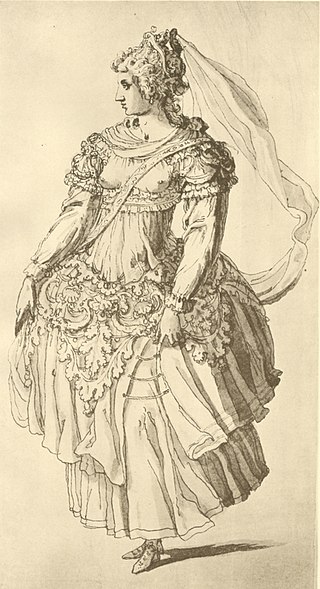
Anne of Denmark was the wife of King James VI and I. She was Queen of Scotland from their marriage on 20 August 1589 and Queen of England and Ireland from the union of the Scottish and English crowns on 24 March 1603 until her death in 1619.

Ludovic Stewart, 2nd Duke of Lennox and 1st Duke of Richmond, lord of the Manor of Cobham, Kent, was a Scottish nobleman who through their paternal lines was a second cousin of King James VI of Scotland and I of England. He was involved in the Plantation of Ulster in Ireland and the colonization of Maine in New England. Richmond's Island and Cape Richmond as well as Richmond, Maine, are named after him. His magnificent monument with effigies survives in Westminster Abbey.

The Masque of Blackness was an early Jacobean era masque, first performed at the Stuart Court in the Banqueting Hall of Whitehall Palace on Twelfth Night, 6 January 1605. It was written by Ben Jonson at the request of Anne of Denmark, the queen consort of King James I, who wished the masquers to be disguised as Africans. Anne was one of the performers in the masque along with her court ladies, all of whom appeared in blackface makeup. In a ceremony earlier on the day, Prince Charles, Anne's second son was given the title of Duke of York.

Margaret Stuart, Scottish aristocrat and courtier in England. She served as lady-in-waiting to the queen consort of England, Anne of Denmark. She was the daughter of James Stewart, 2nd Earl of Moray, and Elizabeth Stuart, 2nd Countess of Moray. The sailor and patron of Ben Jonson, Sir Frances Stuart was her brother.
The Masque of Beauty was a courtly masque written by Ben Jonson, and performed in London's Whitehall Palace on 10 January 1608. It inaugurated the refurbished banquesting hall of the palace. It was a sequel to the preceding Masque of Blackness, which had been performed three years earlier, on 6 January 1605. In The Masque of Beauty, the "daughters of Niger" of the earlier piece were shown cleansed of the black pigment they had worn on the prior occasion.

The Vision of the Twelve Goddesses was an early Jacobean-era masque, written by Samuel Daniel and performed in the Great Hall of Hampton Court Palace on the evening of Sunday, 8 January 1604. One of the earliest of the Stuart Court masques, staged when the new dynasty had been in power less than a year and was closely engaged in peace negotiations with Spain, The Vision of the Twelve Goddesses stood as a precedent and a pattern for the many masques that followed during the next four decades.
Sir Peter Vanlore was a Dutch-born English merchant, jeweller and moneylender in Elizabethan and Stuart England.
Juan de Tassis y Acuña, 1st Count of Villamediana, was a Spanish diplomat and official, awarded his title by king Philip III of Spain in 1603, and the General Head of Spanish Post Offices.

Susan Herbert, Countess of Montgomery, was an English court office holder. She served as lady-in-waiting to the queen consort of England and Scotland, Anne of Denmark. She was the youngest daughter of Elizabethan courtier, and poet Edward de Vere, 17th Earl of Oxford.

Thomas Somerset, 1st Viscount Somerset (1579–1651) was an English politician who sat in the House of Commons between 1601 and 1611. He was raised to the Peerage of Ireland in 1626.
Lady Audrey Walsingham was an English courtier. She served as Lady of the Bedchamber to queen Elizabeth I of England, and then as Mistress of the Robes to Anne of Denmark from 1603 until 1619.

Tethys' Festival was a masque produced on 5 June 1610 to celebrate the investiture of Prince Henry (1594–1612) as Prince of Wales.
Mary Middlemore was a Courtier and Maid of Honour to Anne of Denmark, subject of poems, and treasure hunter.
Dorothy Hastings was a courtier to Elizabeth I of England and Anne of Denmark

Prince Henry's Welcome at Winchester was a masque produced by Anne of Denmark and performed in 1603 at Winchester on a day between 11 and 17 October.

The jewels of Anne of Denmark (1574–1619), wife of James VI and I and queen consort of Scotland and England, are known from accounts and inventories, and their depiction in portraits by artists including Paul van Somer. A few pieces survive. Some modern historians prefer the name "Anna" to "Anne", following the spelling of numerous examples of her signature.

The wedding of Elizabeth Stuart (1596–1662), daughter of James VI and I, and Frederick V of the Palatinate (1596–1632) was celebrated in London in February 1613. There were fireworks, masques, tournaments, and a mock-sea battle or naumachia. Preparations involved the construction of a "Marriage room", a hall adjacent to the 1607 Banqueting House at Whitehall Palace. The events were described in various contemporary pamphlets and letters.
Running at the ring, riding at the ring or tilting at the ring is an equestrian tournament activity originally practiced at European royal courts and likely derived from other lance games like quintain. It gained new popularity at Natural Chimneys near Mount Solon, Virginia, possibly as early as the 1820s, and since 1962, has been the state sport of Maryland. A similar contest, the corrida de sortija, is held in Argentina where it is considered a gaucho sport derived from the Spanish tradition of medieval tournaments.
Christophe de Harlay, Count of Beaumont (1570–1615) was a French politician and diplomat who served as ambassador to England.

Sophia Stuart was the fourth daughter and last of nine children of James VI and I and Anne of Denmark.














